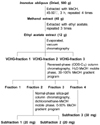1. Sporn MB. Prevention of cancer in the next millennium: report of the chemoprevention working group to the American association for cancer research. Cancer Res. 1999. 59:4743–4758.
2. Roland JF, Chmielewicz ZF, Weiner BA, Gross AM, Boening OP, Luck JV, Bardos TJ, Reilly HC, Sugiura K, Stock CC, Lucas EH, Byerrum RU, Scevena JA. Calvacin: A new antitumor agent. Science. 1960. 132:1897.

3. Gregory FJ, Healy EM, Agersborg HP Jr, Warren GH. Studies on antitumor substances produced by Basidiomycetes. Mycologia. 1966. 58:80–90.

4. Saar M. Fungi in Khanty folk medicine. J Ethnopharmacol. 1991. 31:175–179.

5. Ham SS, Oh SW, Kim YK, Shin KS, Chang HY, Chung GH. Antimutagenic and cytotoxic effects of ethanol extract from the Inonotus obliquus. J Korean Soc Food Sci Nutr. 2003. 32:1088–1094.
6. Ham SS, Oh SW, Kim YK, Shin KS, Chang HY, Chung GH. Antioxidant and genotoxic inhibition activity of ethanol extract from the Inonotus obliquus. J Korean Soc Food Sci Nutr. 2003. 32:1071–1075.
7. Kahlos K, Hiltunen R, Schantz MV. 3β-Hydroxy-lanosta-8,24-dien-21-al, a new triterpene from
Inontus obliquus. Planta Med. 1984. 50:197–198.

8. Ichmura T, Watanave O, Maruyama S. Inhibition of HIV-1 protease by water-soluble lignin-like substance from an edible mushroom Fuscoporia obliqua. Biosci Biotechnol Biochem. 1998. 62:575–577.
9. Nakata T, Yamada T, Taji S, Ohishi H, Wada SI, Tokuda H, Sakuma K, Tanaka R. Structure determination of inonotsuoxides A and B and
in vivo anti-tumor promoting activity of inotodiol from the sclerotia of
Inonotus obliquus. Bioorg Med Chem. 2007. 15:257–264.

10. Lee SH, Hwang HS, Yun JW. Antitumor activity of water extract of a mushroom,
Inonotus obliquus, against HT-29 human colon cancer cells. Phytother Res. 2009. 23:1784–1789.

11. Ham SS, Kim SH, Moon SY, Chung MJ, Cui CB, Han EK, Chung CK, Choe M. Antimutagenic effects of subfractions of Chaga mushroom (
Inonotus obliquus) extract. Mutat Res. 2009. 672:55–59.

12. Chung MJ, Walker PA, Brown RW, Hogstrand C. Zinc-mediated gene expression offers protection against H
2O
2-induced cytotoxicity. Toxicol Appl Pharmacol. 2005. 205:225–236.

13. Ham YA, Choi HJ, Kim SH, Chung MJ, Ham SS. Antimutagenic and antitumor effects of Adenophora triphylla extracts. J Korean Soc Food Sci Nutr. 2009. 38:25–31.
14. Maeda N, Kokai Y, Ohtani S, Hada T, Yoshida H, Mizushina Y. Inhibitory effects of preventive and curative orally administered spinach glycoglycerolipid fraction on the tumor growth of sarcoma and colon in mouse graft models. Food Chem. 2009. 112:205–210.

15. Oh HT, Chung MJ, Kim SH, Choi HJ, Ham SS. Masou salmon (
Oncorhynchus masou) ethanol extract decrease 3-hydroxy-3-methylglutaryl coenzyme A reductase expression in diet-induced obese mice. Nutr Res. 2009. 29:123–129.

16. Kahlos K, Hiltunen R. Identification of some lanostane type triterpenes from Inonotus obliquus. Acta Pharmaceutica Fennica. 1983. 92:220–222.
17. Mizuno T, Zhuang C, Abe K, Okamoto H, Kiho T, Ukai S, Leclerc S, Meijer L. Antitumor and hypoglycemic activities of polysaccharides from the Sclerotia and Mycelia of
Inonotus obliquus (Pers: Fe.) Pll. (Aphyllophoromycetideae). International Journal of Medicinal Mushrooms. 1999. 1:301–316.

18. Kahlos T, Zhuangas L, Hitunen R. Antitumor activity of some compounds and fractions from an n-hexene extract of Inonotus obliquus. Acta Pharmaceutica Fennica. 1987. 96:33–40.
19. Nomura M, Takahashi T, Uesugi A, Tanaka R, Kobayashi S. Inotodiol, a lanostane triterpenoid, from Inonotus obliquus inhibits cell proliferation through caspase-3-dependent apoptosis. Anticancer Res. 2008. 28:2691–2696.
20. Youn MJ, Kim JK, Park SY, Kim Y, Park C, Kim ES, Park Kl, So HS, Park R. Potential anticancer properties of the water extract of
lnonotus obliquus by induction of apoptosis in melanoma B16-F10 cells. J Ethnopharmacol. 2009. 121:221–228.








 PDF
PDF ePub
ePub Citation
Citation Print
Print



 XML Download
XML Download